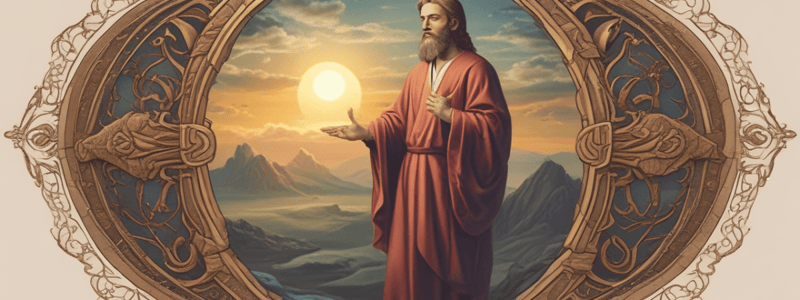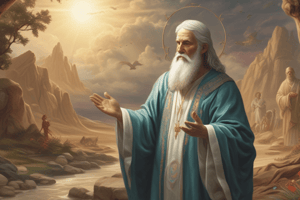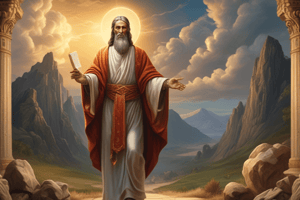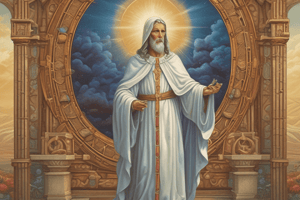Podcast
Questions and Answers
Christ, the Son of God, is not a descendant of David in the flesh.
Christ, the Son of God, is not a descendant of David in the flesh.
False (B)
The kenosis refers to Christ's glorification and exaltation.
The kenosis refers to Christ's glorification and exaltation.
False (B)
Christ, as the Son of God, did not have a humble state or estate or position.
Christ, as the Son of God, did not have a humble state or estate or position.
False (B)
Feinberg's article is about the glorification of Christ.
Feinberg's article is about the glorification of Christ.
The passage suggests that Christ only had a divine nature.
The passage suggests that Christ only had a divine nature.
The theanthropic person refers to a human without divine nature.
The theanthropic person refers to a human without divine nature.
Jesus and the Father are not dependent on each other.
Jesus and the Father are not dependent on each other.
Christ is not prayed for by Jesus in John 17.
Christ is not prayed for by Jesus in John 17.
The hypostatic union refers to the two persons in one nature.
The hypostatic union refers to the two persons in one nature.
The Nicene formula safeguarded the truth of Christ's essential humanity.
The Nicene formula safeguarded the truth of Christ's essential humanity.
The council of Chalcedon was held in 459 AD.
The council of Chalcedon was held in 459 AD.
Nestorianism rejected the union of the natures, resulting in one person.
Nestorianism rejected the union of the natures, resulting in one person.
Uticianism opted to deny the distinction of the natures, resulting in two persons.
Uticianism opted to deny the distinction of the natures, resulting in two persons.
The Chalcedon formula resulted in a lesser deity and a lesser humanity.
The Chalcedon formula resulted in a lesser deity and a lesser humanity.
The debate over the hypostatic union was purely theological in nature.
The debate over the hypostatic union was purely theological in nature.
The hypostatic union refers to one person, one nature.
The hypostatic union refers to one person, one nature.
The early Church had a nicely organized manual about Christ's person laid out in a systematic way.
The early Church had a nicely organized manual about Christ's person laid out in a systematic way.
The union of deity and humanity in one person is a key concept in Christology.
The union of deity and humanity in one person is a key concept in Christology.
The union of natures in Christ's person does not eliminate the distinction of natures.
The union of natures in Christ's person does not eliminate the distinction of natures.
Historianism and Eutichianism are acceptable Christological views.
Historianism and Eutichianism are acceptable Christological views.
The properties of both natures may be attributed to the one person of Christ.
The properties of both natures may be attributed to the one person of Christ.
Eutichianism is the belief that the two natures of Christ are indivisible and inseparable.
Eutichianism is the belief that the two natures of Christ are indivisible and inseparable.
The Chalcedonian formula is non-formulative in its Christology.
The Chalcedonian formula is non-formulative in its Christology.
The divine nature of Christ is capable of suffering.
The divine nature of Christ is capable of suffering.
The person of Jesus is the person of God, inherent in the conception, birth, and life of Jesus.
The person of Jesus is the person of God, inherent in the conception, birth, and life of Jesus.
The divinity of Christ constitutes the root basis of His personality.
The divinity of Christ constitutes the root basis of His personality.
The hypostatic union refers to two persons in one nature.
The hypostatic union refers to two persons in one nature.
The Logos united with a distinct human individual in the womb of the Virgin.
The Logos united with a distinct human individual in the womb of the Virgin.
According to the Chalcedon Creed, Christ is acknowledged in one nature.
According to the Chalcedon Creed, Christ is acknowledged in one nature.
The Council of Chalcedon resultingly led to the belief in a lesser deity and a lesser humanity.
The Council of Chalcedon resultingly led to the belief in a lesser deity and a lesser humanity.
The first two adverbs, 'without confusion' and 'without change', address Eutichianism.
The first two adverbs, 'without confusion' and 'without change', address Eutichianism.
The person of Christ is constituted by His human nature.
The person of Christ is constituted by His human nature.
The person of Jesus Christ is fully human and fully God, but two separate persons.
The person of Jesus Christ is fully human and fully God, but two separate persons.
The conception of Jesus Christ involved a human father and the Virgin Mary.
The conception of Jesus Christ involved a human father and the Virgin Mary.
The hypostatic union refers to the union of two persons in one nature.
The hypostatic union refers to the union of two persons in one nature.
The Council of Chalcedon resulted in a lesser deity and a lesser humanity.
The Council of Chalcedon resulted in a lesser deity and a lesser humanity.
Nestorianism held to the idea that Jesus Christ is only one nature.
Nestorianism held to the idea that Jesus Christ is only one nature.
The kenosis refers to the powers and values of the divine essence being channeled through the human nature of Jesus Christ.
The kenosis refers to the powers and values of the divine essence being channeled through the human nature of Jesus Christ.
The union of the natures in Jesus Christ resulted in a loss of deity and a loss of humanity.
The union of the natures in Jesus Christ resulted in a loss of deity and a loss of humanity.
Jesus Christ is not a descendant of David and Adam.
Jesus Christ is not a descendant of David and Adam.
Flashcards are hidden until you start studying
Study Notes
The Kenosis and Hypostatic Union
- The kenosis refers to Christ's humiliation, where he set aside his glory and divine attributes to become fully human, taking on the likeness of men and making his dwelling place on earth.
- The hypostatic union refers to the union of Christ's divine and human natures in one person.
The Council of Chalcedon (451 AD)
- The council issued a creed that safeguarded the truth of Christ's essential humanity and divinity.
- The creed was formulated to settle the Christological debates of the time, particularly Nestorianism and Uticianism.
Nestorianism and Uticianism
- Nestorianism:
- Divided the natures of Christ, keeping them separate, resulting in two persons (Jesus and the Son of God).
- Denied the union of the natures.
- Uticianism:
- Merged the natures, resulting in a mixed nature, neither fully human nor fully divine.
- Denied the distinction of the natures.
The Chalcedonian Formula
- Defined the parameters for doctrinal formulation on Christology.
- Recognized the union of deity and humanity in one person, with a proper distinction of the natures.
- Attributed properties of both natures to the one person of Christ.
Key Adverbs
- Without confusion (no mixing of natures)
- Without change (no alteration of natures)
- Without division (no separation of natures)
- Without separation (no separation of natures)
Implications of the Hypostatic Union
- The person of Jesus is the person of God, who assumed human nature.
- The union of the natures was affected in the womb of the Virgin Mary.
- Christ has a fully human nature, with emotions, intellect, and will, but remained fully God.
- The divinity of Christ constitutes the root and basis of his personality.
Christ's Humanity and Divinity
- Christ's humanity was not subject to his divinity, but rather, the divine essence channeled through the kenosis its powers and values to the human nature.
- The person of Jesus, who assumed human nature, is the second person of the Godhead, fully incarnated, fully human, and fully God.
Studying That Suits You
Use AI to generate personalized quizzes and flashcards to suit your learning preferences.




